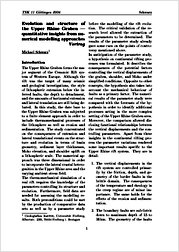Evolution and structure of the Upper Rhine Graben — quantitative insights from numerical modelling approaches
Schwarz, Michael
Universitätsverlag Göttingen
Sammelband- / Konferenzbeitrag
Verlagsversion
Deutsch
Schwarz, Michael, 2006: Evolution and structure of the Upper Rhine Graben — quantitative insights from numerical modelling approaches. In: Philipp, S.; Leiss, B; Vollbrecht, A.; Tanner, D.; Gudmundsson, A. (eds.): 11. Symposium "Tektonik, Struktur- und Kristallingeologie"; 2006, Univ.-Verl. Göttingen, p. 205 - 207., , DOI: 10.23689/fidgeo-1883.
 |
Dokument öffnen: |
The Upper Rhine Graben forms the major
segment of the Cenozoic Rift system
of Western Europe. Although the
rift was the target of many seismic
and geological investigations, the style
of lithospheric extension below the inferred
faults, the depth to detachment, and the amounts of horizontal extension
and lateral translation are still being debated.
In this study, the date base to
the Upper Rhine Graben was subjected
to a finite element approach in order to
include thermomechanical processes of
the lithosphere as well as erosion and
sedimentation. The study concentrated
on the consequences of extension and
lateral translational events on the structure
and evolution in terms of basin
geometry, sediment layer thicknesses,
Moho elevation, and shoulder uplift on
a lithospheric scale. The numerical approach
was three dimensional in order
to incorporate the lateral crustal heterogenities
in the Upper Rhine area and the
varying ambient stress field...

